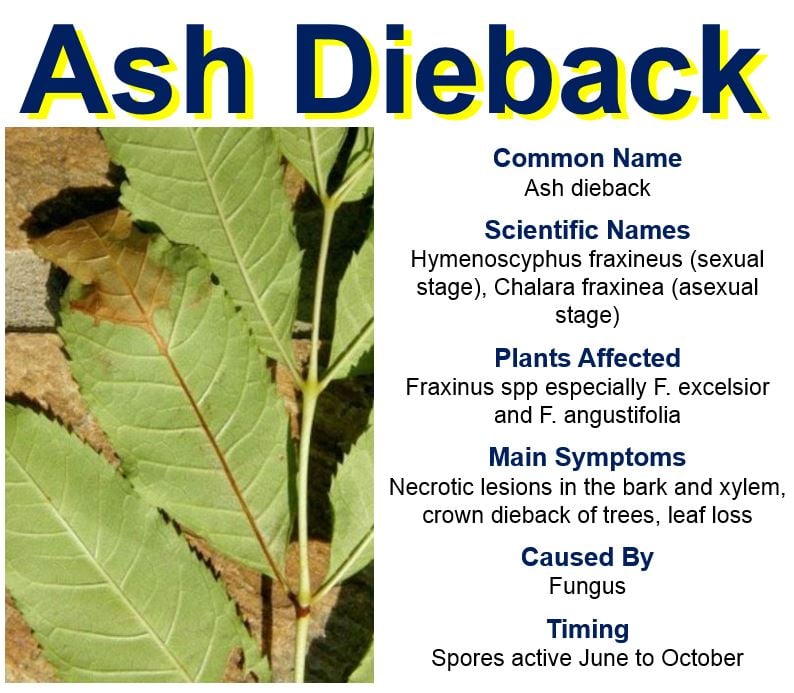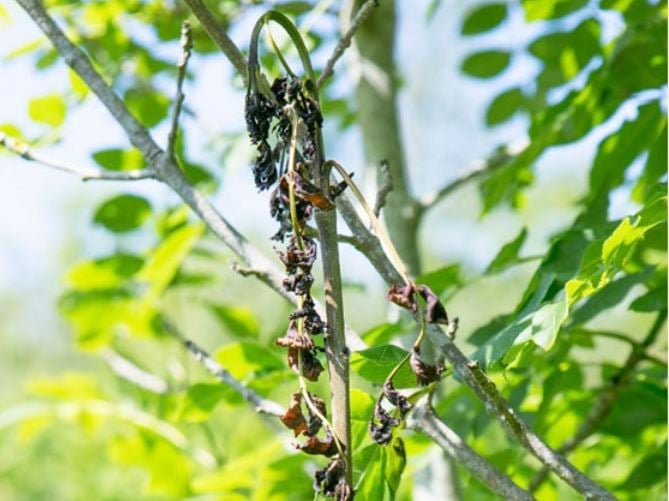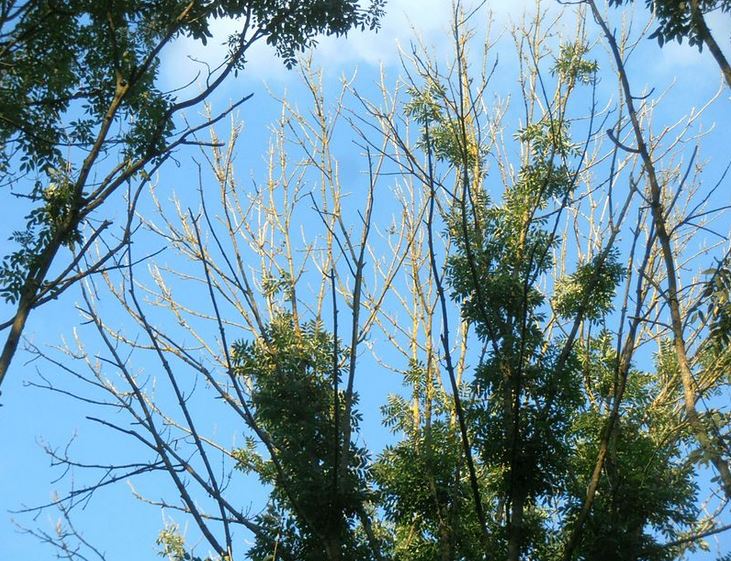Scientists have discovered a mature ash tree that has fought off Ash Dieback Disease – also known as Chalara Dieback of Ash – offering renewed hope to protect our woodlands and forests.
Ash dieback is a serious disease that is killing ash trees in the UK and across Europe. Ash is an extremely important tree in Britain, both culturally and ecologically – the disease is causing major concern regarding the damage that it will do.
On Friday, scientists in Norwich, England, announced a major breakthrough in their research after locating a healthy ash nicknamed Betty in Ashwellthorpe Wood, near Wymondham, Norfolk.
 According to the Royal Horticultural Society: “Hymenoscyphus fraxineus causes a lethal disease of ash and represents a substantial threat both to the UK’s forests and to amenity trees growing in parks and gardens.” (Image: rhs.org.uk)
According to the Royal Horticultural Society: “Hymenoscyphus fraxineus causes a lethal disease of ash and represents a substantial threat both to the UK’s forests and to amenity trees growing in parks and gardens.” (Image: rhs.org.uk)
Single ash tree fought off infection
Despite being surrounded by infection, this tree has a strong resistance to ash dieback.
This promising breakthrough follows a survey of ash trees, published in the Journal of Ecology, which warned of the a double whammy: 1. The spread of ash dieback disease and, 2. The potential spread of borer beetles from Russia.
After ash dieback was discovered in Britain four years ago, the Nornex consortium – an alliance of scientists – was set up.
Nornex co-ordinator, Allan Downie, who is also emeritus fellow at the John Innes Centre, and colleagues compared the genetics of ash trees. They developed three genetic markers which allowed them to predict which trees are likely to be tolerant of the disease.
Betty was found to have a surprisingly strong tolerance. This discovery could lead to ‘selective breeding’, i.e. developing ash trees that are resistant to the disease.
 Symptoms of ash dieback include saplings with dead tops and shrivelled, blackened shoots. (Image: woodlandtrust.org.uk. Credit: David McHugh/WTML)
Symptoms of ash dieback include saplings with dead tops and shrivelled, blackened shoots. (Image: woodlandtrust.org.uk. Credit: David McHugh/WTML)
Professor Downie said:
“The identification of genetic markers for trees with low susceptibility to ash dieback is a large first step, one of many that will be needed in the fight to help ash trees survive this disease epidemic.”
Fast progress finding disease-resistant tree
The scientists said they were ‘astonished’ to have come so far in such a short time.
Lords spokesman for DEFRA (Department of the Environment, Fisheries and Rural Affairs), Lord Gardiner, presented the scientists’ latest findings at the John Innes Centre in Norfolk today.
Lord Gardiner said:
“This Government has invested more than any other country in research on ash dieback, and today’s breakthrough is an excellent example of how the UK’s cutting-edge science is leading the way to help support tree health.”
“We want to guarantee the graceful ash tree continues to have a place in our environment for centuries to come and this vital work is a major step towards ensuring just that.”
According to Nornex scientists, the three genetic markers are more prevalent in British ash trees than in those from some other parts of the world. Nobody knows why yet, but this should be taken into consideration when creating future tree development programmes, they said.
 Trees suffering from ash dieback were first reported dying in large numbers in 1992 in Poland. (Image: woodlandtrust.org.uk)
Trees suffering from ash dieback were first reported dying in large numbers in 1992 in Poland. (Image: woodlandtrust.org.uk)
UK Chief Plant Health Officer, Nicola Spence, said:
“This unprecedented work conducted by British scientists has uncovered an exciting development in tree health.”
“It paves the way for tackling this destructive disease and will help ensure that Britain’s stock of ash trees, and its countryside, remains resilient against pests and disease in the future.”
BBSRC (Biotechnology and Biological Sciences Research Council) Chief Executive, Prof. Melanie Welham, said:
“Working across Government we issued this rapid response to ensure the UK’s excellent plant science base was primed to help combat the threat of ash dieback.”
“Tree pests and pathogens present a significant challenge to our woodlands and habitats, but through fundamental bioscience research we can gain the vital insights needed to help protect the UK’s trees.”
 Crown dieback in a mature ash tree. (Image: Wikipedia)
Crown dieback in a mature ash tree. (Image: Wikipedia)
What is ash dieback disease?
According to OpenAshDieBack, a hub for crowdsourcing information and genomic resources for Ash Dieback, Ash dieback disease is caused by a fungus called Hymenoscyphus pseudoalbidus. It is a chronic (long-term) fungal disease of European ash trees characterised by serious leaf loss and crown dieback in infected trees.
The fungus was initially described scientifically in 2006 under the name Chalara fraxinea. By 2010, scientists discovered that Chalara fraxinea was only the anamorphic (asexual) stage of a fungus that was subsequently name Hymenoscyphus pseudoalbidus.
What are the symptoms of ash dieback disease?
At first, small necrotic spots become visible on the branches and stems. These then get larger, resulting in wilting, dieback of branches, and particularly death of the top part of the crown.
The disease is usually chronic, but can sometimes kill the tree. Young ash plants are more severely affected. It is not uncommon for young plants to die within two years of symptoms becoming visible.
Older trees tend to fare batter, but eventually also succumb after several seasons of infection.
A huge number of trees, particularly in northern and eastern Europe, have been affected by ash dieback since the mid-1990s.
Between 60% and 90% of ash trees in Denmark and over 50% in Sweden have evident damage, while 25% are severely injured.
In 2012, the disease was first discovered in Britain, initially only on imported nursery plants. By October 2012, it was spotted at two sites of established woodland in East Anglia.
According to OpenAshDieBack:
“Research into the genetics of the resistance of ash has shown that resistance does occur in European populations, but, at least for the samples tested, it is neither common nor strong.”
Citation
“An open consortium (Nornex) for molecular understanding of ash dieback disease,” Evidence Project Final Report. Department for Environment Food & Rural Affairs (DEFRA). Project Code: NORNEX.
Video – Chalara ash dieback: winter symptoms
Area Director for the Forestry Commission, Steve Scott, explains in this video how to spot ash dieback (Chalara fraxinea) in winter.
